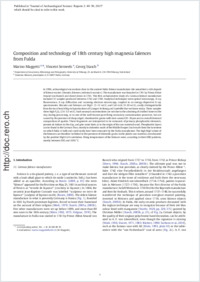Composition and technology of 18th century high magnesia faïences from Fulda
DOKPE
- Maggetti, Marino Department of Geosciences, Mineralogy and Petrography, University of Fribourg, Switzerland
- Serneels, Vincent Department of Geosciences, Mineralogy and Petrography, University of Fribourg, Switzerland
- Stasch, Georg Vonderau Museum, Fulda, Germany
-
08.01.2015
Published in:
- Journal of Archaeological Science: Reports. - 2015, vol. 2, p. 40–50
English
In 1996, archaeological excavations close to the ancient Fulda faïence manufacture site unearthed a rich deposit of faïence wastes (biscuits, faïences, technical ceramics). The manufacture was founded in 1741 by Prince Abbot Amand von Buseck and closed down in 1761. This first archaeometric study of a German faïence manufacture included 31 samples produced between 1742 and 1760. Analytical techniques were optical microscopy, X-ray fluorescence, X-ray diffraction and scanning electron microscopy, coupled to an energy-dispersive X-ray spectrometer. Biscuits and faïences are MgO- (5–13 wt.%) and CaO-rich (9–20 wt.%), easily distinguishable from the two French Mg-rich productions of Granges-le-Bourg and Lunéville that we know today. Three samples show high P₂O₅ (2.6–3.3 wt.%). Such unusual concentrations are not due to the admixing of crushed bones to the clay during processing, or to one of the well-known post-firing secondary contamination processes, but are caused by the presence of sharp edged, rhomboedric grains with sizes around 20–30 μm and an overall chemical composition of apatite. These fragments are interpreted to be remnants of primary phosphoritic elements, present ab initium in the clay, and give some hints as to the origin of the raw materials used. Phosphoritic layers can be found in the German Trias, mostly in dolomitic marls of the Middle Keuper. Such marls form the basement on which Fulda is built and could easily have been extracted by the Fulda manufacture. The high MgO values of the faïences can therefore be linked to the presence of dolomitic grains in the plastic raw material, corroborated by the positive MgO/CaO correlation. Firing temperatures of the faïences were, according to their XRD patterns, mostly between 950 and 1050 °C.
- Faculty
- Faculté des sciences et de médecine
- Department
- Département de Géosciences
- Language
-
- English
- Classification
- Archeology
- License
-
License undefined
- Identifiers
-
- RERO DOC 234359
- DOI 10.1016/j.jasrep.2014.12.004
- Persistent URL
- https://folia.unifr.ch/unifr/documents/304315
Statistics
Document views: 137
File downloads:
- pdf: 223
